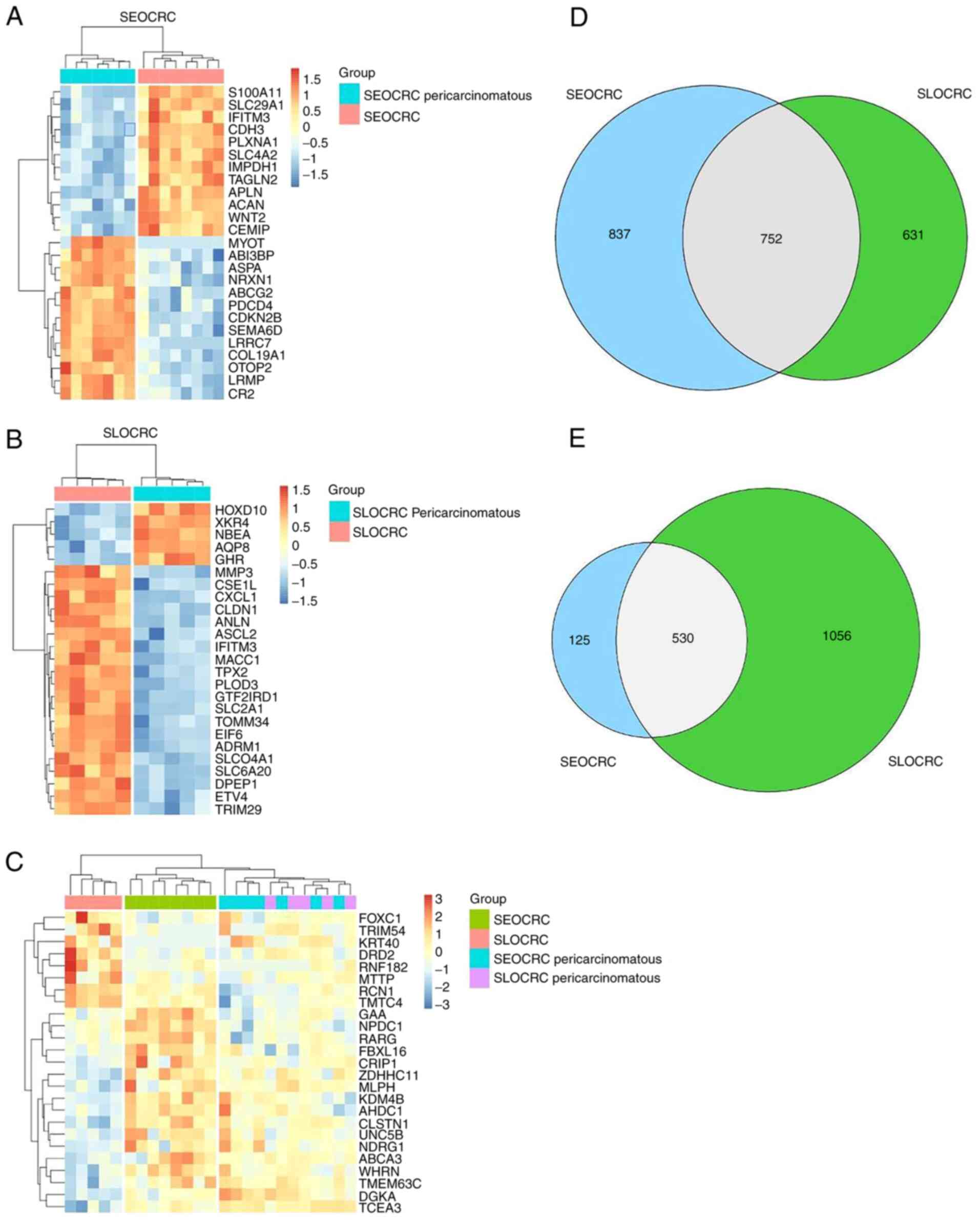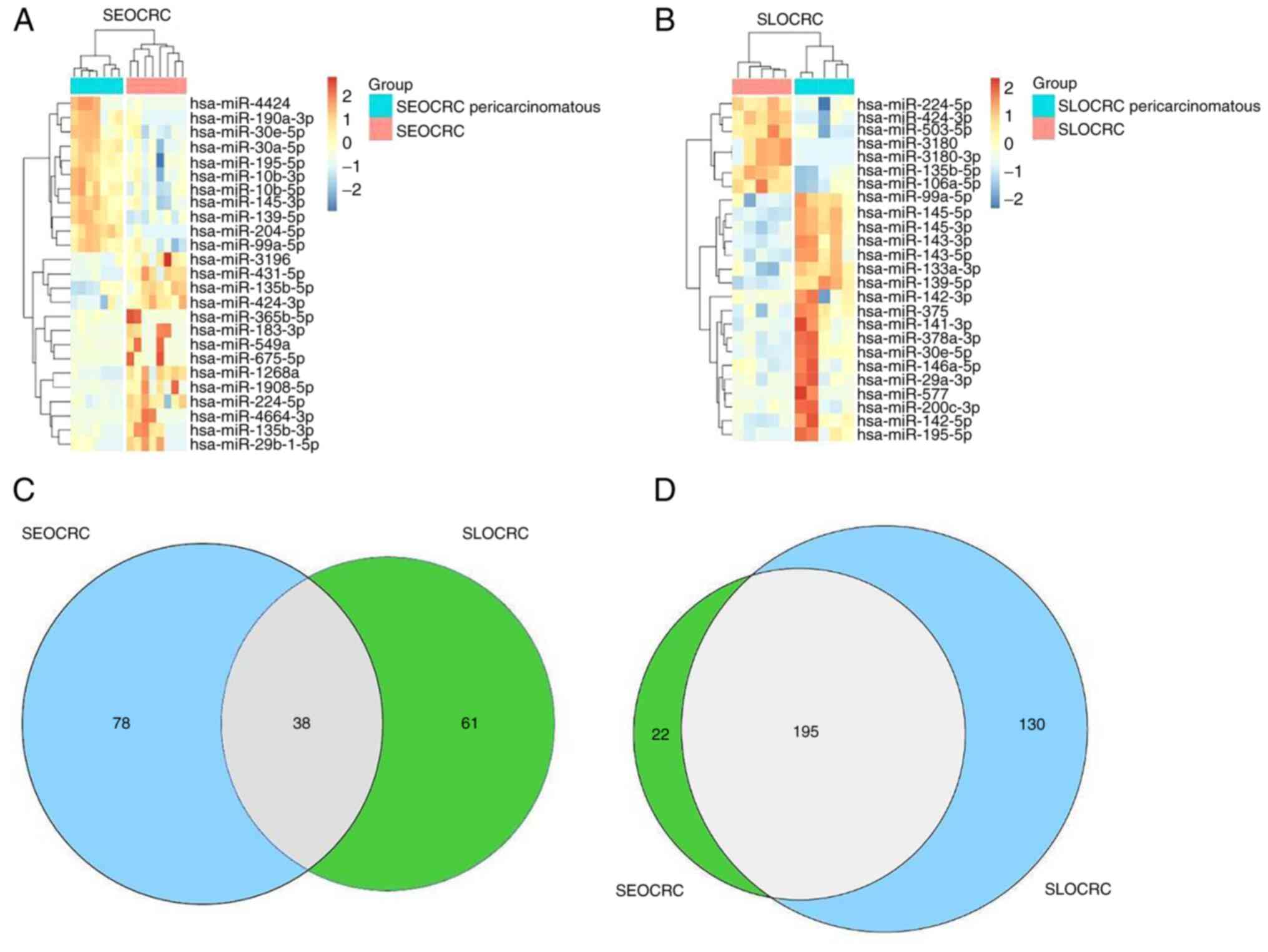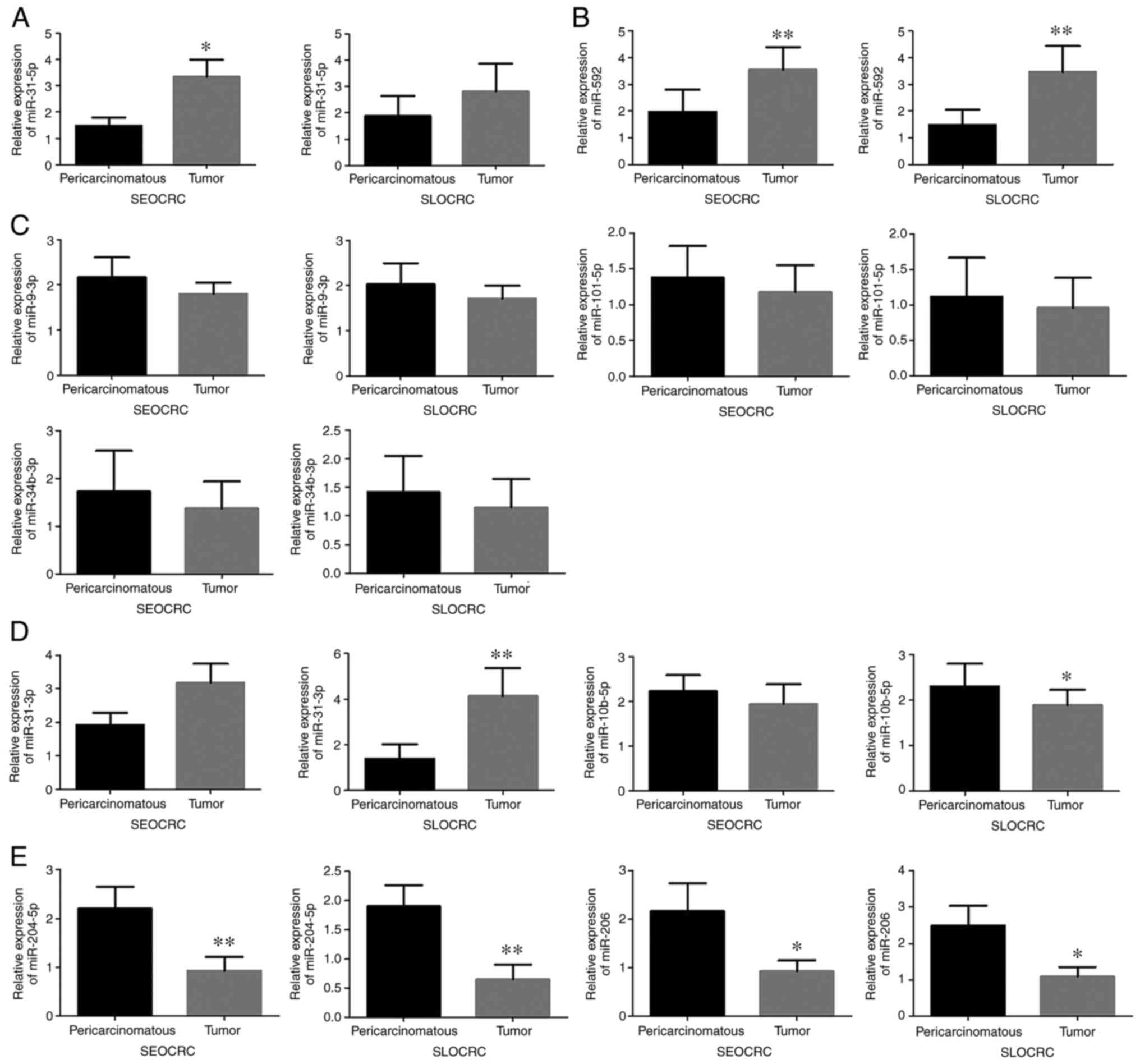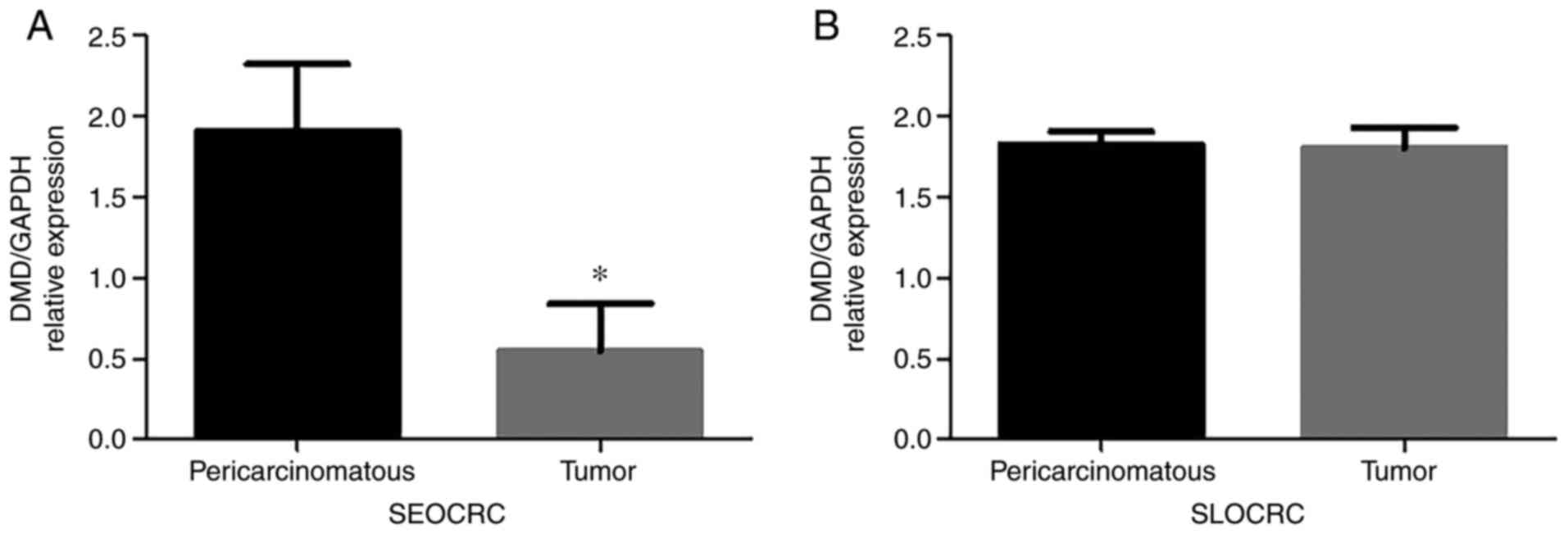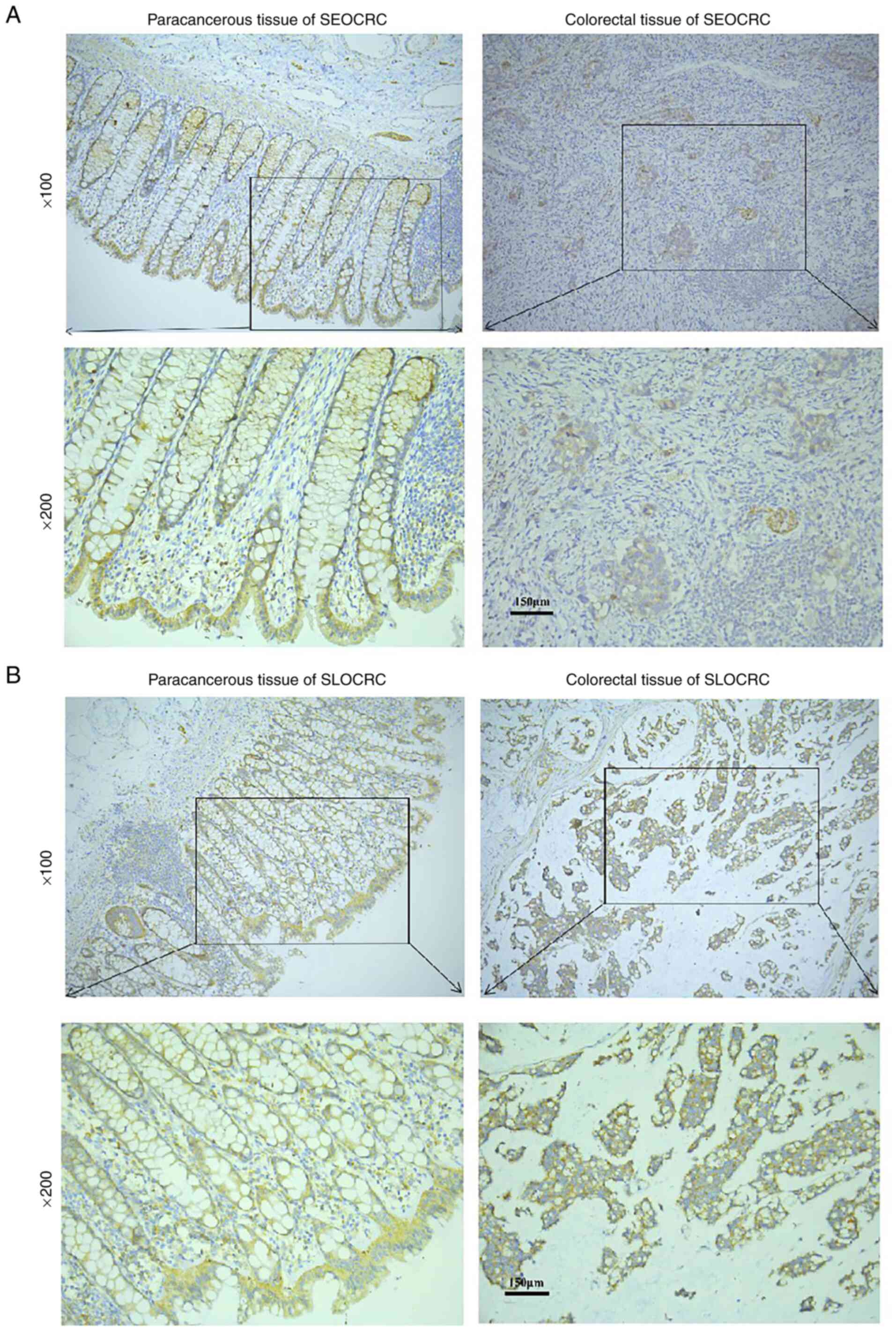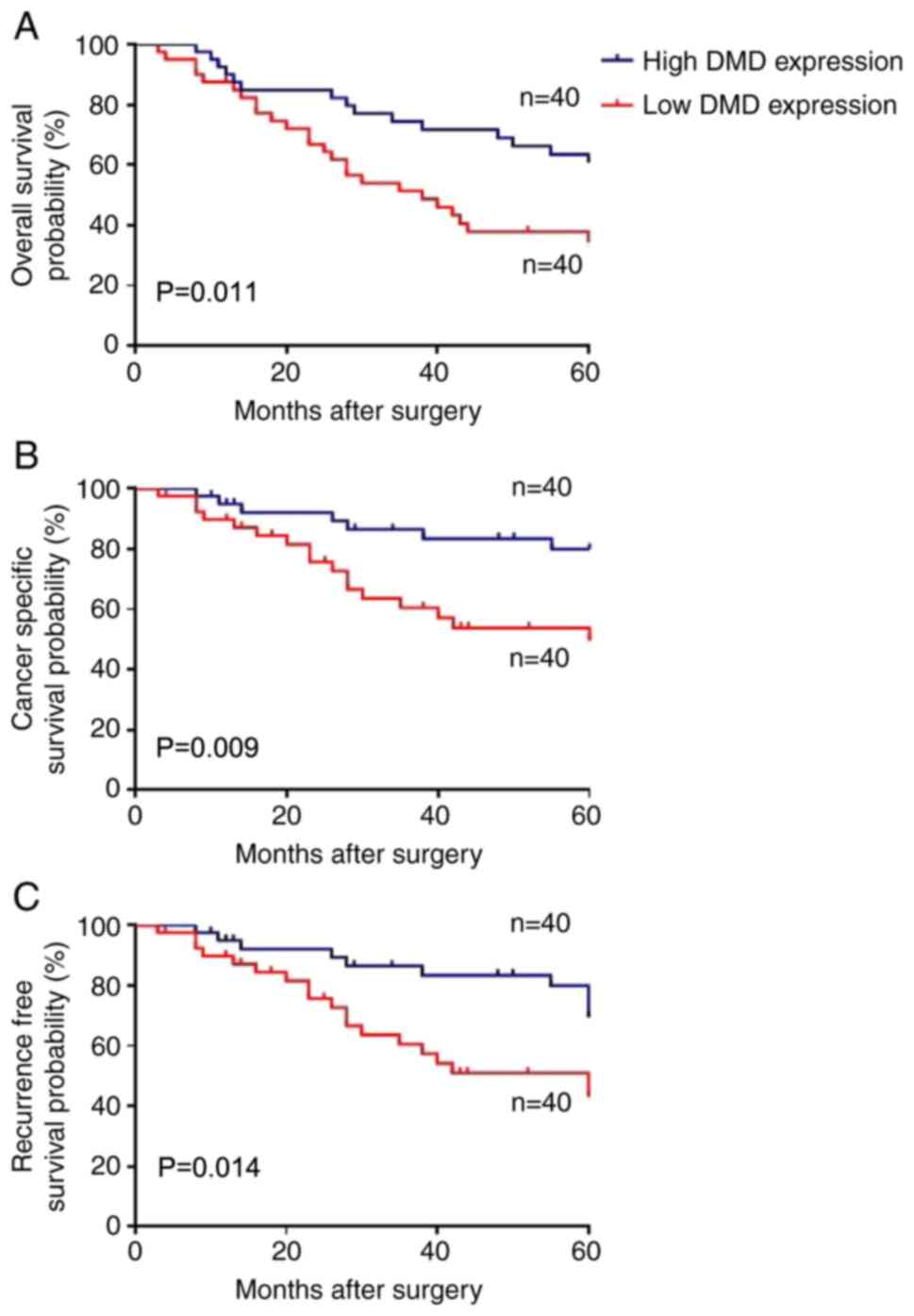|
1
|
Bray F, Ferlay J, Soerjomataram I, Siegel
RL, Torre LA and Jemal A: Global cancer statistics 2018: GLOBOCAN
estimates of incidence and mortality worldwide for 36 cancers in
185 countries. CA Cancer J Clin. 68:394–424. 2018. View Article : Google Scholar : PubMed/NCBI
|
|
2
|
Jayasekara H, English DR, Haydon A, Hodge
AM, Lynch BM, Rosty C, Williamson EJ, Clendenning M, Southey MC,
Jenkins MA, et al: Associations of alcohol intake, smoking,
physical activity and obesity with survival following colorectal
cancer diagnosis by stage, anatomic site and tumor molecular
subtype. Int J Cancer. 142:238–250. 2018. View Article : Google Scholar : PubMed/NCBI
|
|
3
|
Mármol I, Sánchez-de-Diego C, Pradilla
Dieste A, Cerrada E and Rodriguez Yoldi MJ: Colorectal carcinoma: A
general overview and future perspectives in colorectal cancer. Int
J Mol Sci. 18:1972017. View Article : Google Scholar : PubMed/NCBI
|
|
4
|
Loomans-Kropp HA and Umar A: Increasing
incidence of colorectal cancer in young adults. J Cancer Epidemiol.
2019:98412952019. View Article : Google Scholar : PubMed/NCBI
|
|
5
|
Patel SG and Ahnen DJ: Colorectal cancer
in the young. Curr Gastroenterol Rep. 20:152018. View Article : Google Scholar : PubMed/NCBI
|
|
6
|
Yeo H, Betel D, Abelson JS, Zheng XE,
Yantiss R and Shah MA: Early-onset colorectal cancer is distinct
from traditional colorectal cancer. Clin Colorectal Cancer.
16:293–299.e6. 2017. View Article : Google Scholar : PubMed/NCBI
|
|
7
|
Burnett-Hartman AN, Powers JD, Chubak J,
Corley DA, Ghai NR, McMullen CK, Pawloski PA, Sterrett AT and
Feigelson HS: Treatment patterns and survival differ between
early-onset and late-onset colorectal cancer patients: The patient
outcomes to advance learning network. Cancer Causes Control.
30:747–755. 2019. View Article : Google Scholar : PubMed/NCBI
|
|
8
|
Strum WB and Boland CR: Clinical and
genetic characteristics of colorectal cancer in persons under 50
years of age: A review. Dig Dis Sci. 64:3059–3065. 2019. View Article : Google Scholar : PubMed/NCBI
|
|
9
|
Stigliano V, Sanchez-Mete L, Martayan A
and Anti M: Early-onset colorectal cancer: A sporadic or inherited
disease? World J Gastroenterol. 20:12420–12430. 2014. View Article : Google Scholar : PubMed/NCBI
|
|
10
|
Pearlman R, Frankel WL, Swanson B, Zhao W,
Yilmaz A, Miller K, Bacher J, Bigley C, Nelsen L, Goodfellow PJ, et
al: Prevalence and spectrum of germline cancer susceptibility gene
mutations among patients with early-onset colorectal cancer. JAMA
Oncol. 3:464–471. 2017. View Article : Google Scholar : PubMed/NCBI
|
|
11
|
Mo X, Su Z, Yang B, Zeng Z, Lei S and Qiao
H: Identification of key genes involved in the development and
progression of early-onset colorectal cancer by co-expression
network analysis. Oncol Lett. 19:177–186. 2020.PubMed/NCBI
|
|
12
|
Pertea M, Kim D, Pertea GM, Leek JT and
Salzberg SL: Transcript-level expression analysis of RNA-seq
experiments with HISAT, StringTie and Ballgown. Nat Protoc.
11:1650–1667. 2016. View Article : Google Scholar : PubMed/NCBI
|
|
13
|
Robinson MD, McCarthy DJ and Smyth GK:
edgeR: A bioconductor package for differential expression analysis
of digital gene expression data. Bioinformatics. 26:139–140. 2010.
View Article : Google Scholar : PubMed/NCBI
|
|
14
|
Benjamini Y: Discovering the false
discovery rate. J R Stat Soc B. 72:405–416. 2010. View Article : Google Scholar
|
|
15
|
Livak KJ and Schmittgen TD: Analysis of
relative gene expression data using real-time quantitative PCR and
the 2(−Delta Delta C(T)) method. Methods. 25:402–408. 2001.
View Article : Google Scholar : PubMed/NCBI
|
|
16
|
Gu S, Lin S, Ye D, Qian S, Jiang D, Zhang
X, Li Q, Yang J, Ying X, Li Z, et al: Genome-wide methylation
profiling identified novel differentially hypermethylated biomarker
MPPED2 in colorectal cancer. Clin Epigenetics. 11:412019.
View Article : Google Scholar : PubMed/NCBI
|
|
17
|
Kubota N, Taniguchi F, Nyuya A, Umeda Y,
Mori Y, Fujiwara T, Tanioka H, Tsuruta A, Yamaguchi Y and Nagasaka
T: Upregulation of microRNA-31 is associated with poor prognosis in
patients with advanced colorectal cancer. Oncol Lett. 19:2685–2694.
2020.PubMed/NCBI
|
|
18
|
Ren TJ, Liu C, Hou JF and Shan FX:
CircDDX17 reduces 5-fluorouracil resistance and hinders
tumorigenesis in colorectal cancer by regulating miR-31-5p/KANK1
axis. Eur Rev Med Pharmacol Sci. 24:1743–1754. 2020.PubMed/NCBI
|
|
19
|
Sur D, Cainap C, Burz C, Havasi A, Chis
IC, Vlad C, Milosevic V, Balacescu O and Irimie A: The role of
miRNA-31-3p and miR-31-5p in the anti-EGFR treatment efficacy of
wild-type K-RAS metastatic colorectal cancer. Is it really the next
best thing in miRNAs? J BUON. 24:1739–1746. 2019.PubMed/NCBI
|
|
20
|
Hsu HH, Kuo WW, Shih HN, Cheng SF, Yang
CK, Chen MC, Tu CC, Viswanadha VP, Liao PH and Huang CY: FOXC1
regulation of miR-31-5p confers oxaliplatin resistance by targeting
LATS2 in colorectal cancer. Cancers (Basel). 11:15762019.
View Article : Google Scholar : PubMed/NCBI
|
|
21
|
De Robertis M, Mazza T, Fusilli C,
Loiacono L, Poeta ML, Sanchez M, Massi E, Lamorte G, Diodoro MG,
Pescarmona E, et al: EphB2 stem-related and EphA2
progression-related miRNA-based networks in progressive stages of
CRC evolution: Clinical significance and potential miRNA drivers.
Mol Cancer. 17:1692018. View Article : Google Scholar : PubMed/NCBI
|
|
22
|
Cacchiarelli D, Incitti T, Martone J,
Cesana M, Cazzella V, Santini T, Sthandier O and Bozzoni I: miR-31
modulates dystrophin expression: New implications for Duchenne
muscular dystrophy therapy. EMBO Rep. 12:136–141. 2011. View Article : Google Scholar : PubMed/NCBI
|
|
23
|
Koumangoye RB, Andl T, Taubenslag KJ,
Zilberman ST, Taylor CJ, Loomans HA and Andl CD: SOX4 interacts
with EZH2 and HDAC3 to suppress microRNA-31 in invasive esophageal
cancer cells. Mol Cancer. 14:242015. View Article : Google Scholar : PubMed/NCBI
|
|
24
|
Suzuki H, Yamamoto E, Nojima M, Kai M,
Yamano HO, Yoshikawa K, Kimura T, Kudo T, Harada E, Sugai T, et al:
Methylation-associated silencing of microRNA-34b/c in gastric
cancer and its involvement in an epigenetic field defect.
Carcinogenesis. 31:2066–2073. 2010. View Article : Google Scholar : PubMed/NCBI
|
|
25
|
Gabriely G, Yi M, Narayan RS, Niers JM,
Wurdinger T, Imitola J, Ligon KL, Kesari S, Esau C, Stephens RM, et
al: Human glioma growth is controlled by microRNA-10b. Cancer Res.
71:3563–3572. 2011. View Article : Google Scholar : PubMed/NCBI
|
|
26
|
Geekiyanage H and Galanis E: MiR-31 and
miR-128 regulates poliovirus receptor-related 4 mediated measles
virus infectivity in tumors. Mol Oncol. 10:1387–1403. 2016.
View Article : Google Scholar : PubMed/NCBI
|
|
27
|
Chen PH, Chang CK, Shih CM, Cheng CH, Lin
CW, Lee CC, Liu AJ, Ho KH and Chen KC: The miR-204-3p-targeted
IGFBP2 pathway is involved in xanthohumol-induced glioma cell
apoptotic death. Neuropharmacology. 110:362–375. 2016. View Article : Google Scholar : PubMed/NCBI
|
|
28
|
Sim SE, Lim CS, Kim JI, Seo D, Chun H, Yu
NK, Lee J, Kang SJ, Ko HG, Choi JH, et al: The brain-enriched
MicroRNA miR-9-3p regulates synaptic plasticity and memory. J
Neurosci. 36:8641–8652. 2016. View Article : Google Scholar : PubMed/NCBI
|
|
29
|
Zhang YJ, Xu F, Zhang YJ, Li HB, Han JC
and Li L: miR-206 inhibits non small cell lung cancer cell
proliferation and invasion by targeting SOX9. Int J Clin Exp Med.
8:9107–9113. 2015.PubMed/NCBI
|
|
30
|
Liu N, Zhang L, Wang Z, Cheng Y, Zhang P,
Wang X, Wen W, Yang H, Liu H and Jin W: MicroRNA-101 inhibits
proliferation, migration and invasion of human glioblastoma by
targeting SOX9. Oncotarget. 8:19244–19254. 2017. View Article : Google Scholar : PubMed/NCBI
|
|
31
|
Zhu Q, Gong L, Wang J, Tu Q, Yao L, Zhang
JR, Han XJ, Zhu SJ, Wang SM, Li YH, et al: miR-10b exerts oncogenic
activity in human hepatocellular carcinoma cells by targeting
expression of CUB and sushi multiple domains 1 (CSMD1). BMC Cancer.
16:8062016. View Article : Google Scholar : PubMed/NCBI
|
|
32
|
Cavestro GM, Mannucci A, Zuppardo RA, Di
Leo M, Stoffel E and Tonon G: Early onset sporadic colorectal
cancer: Worrisome trends and oncogenic features. Dig Liver Dis.
50:521–532. 2018. View Article : Google Scholar : PubMed/NCBI
|
|
33
|
Lieu CH, Golemis EA, Serebriiskii IG,
Newberg J, Hemmerich A, Connelly C, Messersmith WA, Eng C, Eckhardt
SG, Frampton G, et al: Comprehensive genomic landscapes in early
and later onset colorectal cancer. Clin Cancer Res. 25:5852–5858.
2019. View Article : Google Scholar : PubMed/NCBI
|
|
34
|
Thutkawkorapin J, Lindblom A and Tham E:
Exome sequencing in 51 early onset non-familial CRC cases. Mol
Genet Genomic Med. 7:e6052019. View Article : Google Scholar : PubMed/NCBI
|
|
35
|
Lu Z, He Q, Liang J, Li W, Su Q, Chen Z,
Wan Q, Zhou X, Cao L, Sun J, et al: miR-31-5p is a potential
circulating biomarker and therapeutic target for oral cancer. Mol
Ther Nucleic Acids. 16:471–480. 2019. View Article : Google Scholar : PubMed/NCBI
|
|
36
|
Li Y, Quan J, Chen F, Pan X, Zhuang C,
Xiong T, Zhuang C, Li J, Huang X, Ye J, et al: MiR-31-5p acts as a
tumor suppressor in renal cell carcinoma by targeting
cyclin-dependent kinase 1 (CDK1). Biomed Pharmacother. 111:517–526.
2019. View Article : Google Scholar : PubMed/NCBI
|
|
37
|
Peng H, Wang L, Su Q, Yi K, Du J and Wang
Z: MiR-31-5p promotes the cell growth, migration and invasion of
colorectal cancer cells by targeting NUMB. Biomed Pharmacother.
109:208–216. 2019. View Article : Google Scholar : PubMed/NCBI
|
|
38
|
Yi SJ, Liu P, Chen BL, Ou-Yang L, Xiong WM
and Su JP: Circulating miR-31-5p may be a potential diagnostic
biomarker in nasopharyngeal carcinoma. Neoplasma. 66:825–829. 2019.
View Article : Google Scholar : PubMed/NCBI
|
|
39
|
Chen Y, Zhao H, Li H, Feng X, Tang H, Qiu
C, Zhang J and Fu B: LINC01234/MicroRNA-31-5p/MAGEA3 axis mediates
the proliferation and chemoresistance of hepatocellular carcinoma
cells. Mol Ther Nucleic Acids. 19:168–178. 2020. View Article : Google Scholar : PubMed/NCBI
|
|
40
|
Li H, Shi H, Zhang F, Xue H, Wang L, Tian
J, Xu J and Han Q: LncRNA Tincr regulates PKCε expression in a
miR-31-5p-dependent manner in cardiomyocyte hypertrophy. Naunyn
Schmiedebergs Arch Pharmacol. 393:2495–2506. 2020. View Article : Google Scholar : PubMed/NCBI
|
|
41
|
Li W, Yu N, Fan L, Chen SH and Wu JL:
Circ_0063517 acts as ceRNA, targeting the miR-31-5p-ETBR axis to
regulate angiogenesis of vascular endothelial cells in
preeclampsia. Life Sci. 244:1173062020. View Article : Google Scholar : PubMed/NCBI
|
|
42
|
Tasena H, Boudewijn IM, Faiz A, Timens W,
Hylkema MN, Berg M, Ten Hacken NHT, Brandsma CA, Heijink IH and van
den Berge M: MiR-31-5p: A shared regulator of chronic mucus
hypersecretion in asthma and chronic obstructive pulmonary disease.
Allergy. 75:703–706. 2020. View Article : Google Scholar : PubMed/NCBI
|
|
43
|
Chamberlain JR and Chamberlain JS:
Progress toward gene therapy for duchenne muscular dystrophy. Mol
Ther. 25:1125–1131. 2017. View Article : Google Scholar : PubMed/NCBI
|
|
44
|
Okubo M, Noguchi S, Hayashi S, Nakamura H,
Komaki H, Matsuo M and Nishino I: Exon skipping induced by
nonsense/frameshift mutations in DMD gene results in Becker
muscular dystrophy. Hum Genet. 139:247–255. 2020. View Article : Google Scholar : PubMed/NCBI
|
|
45
|
Kamdar F and Garry DJ:
Dystrophin-deficient cardiomyopathy. J Am Coll Cardiol.
67:2533–2546. 2016. View Article : Google Scholar : PubMed/NCBI
|
|
46
|
Luce LN, Abbate M, Cotignola J and
Giliberto F: Non-myogenic tumors display altered expression of
dystrophin (DMD) and a high frequency of genetic alterations.
Oncotarget. 8:145–155. 2017. View Article : Google Scholar : PubMed/NCBI
|
|
47
|
Juratli TA, McCabe D, Nayyar N, Williams
EA, Silverman IM, Tummala SS, Fink AL, Baig A, Martinez-Lage M,
Selig MK, et al: DMD genomic deletions characterize a subset of
progressive/higher-grade meningiomas with poor outcome. Acta
Neuropathol. 136:779–792. 2018. View Article : Google Scholar : PubMed/NCBI
|
|
48
|
Mauduit O, Delcroix V, Lesluyes T, Pérot
G, Lagarde P, Lartigue L, Blay JY and Chibon F: Recurrent DMD
deletions highlight specific role of Dp71 isoform in soft-tissue
sarcomas. Cancers (Basel). 11:9222019. View Article : Google Scholar : PubMed/NCBI
|
|
49
|
Saba KH, Cornmark L, Rissler M, Fioretos
T, Åström K, Haglund F, Rosenberg AE, Brosjö O and Nord KH: Genetic
profiling of a chondroblastoma-like osteosarcoma/malignant
phosphaturic mesenchymal tumor of bone reveals a homozygous
deletion of CDKN2A, intragenic deletion of DMD, and a targetable
FN1-FGFR1 gene fusion. Genes Chromosomes Cancer. 58:731–736. 2019.
View Article : Google Scholar : PubMed/NCBI
|















